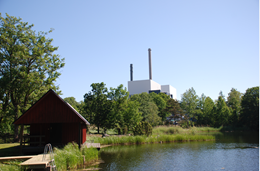Preparing the transition to decommissioning
Plant Story
Vol 31 No 2 2021
26 July 2021
Harriet Kallio, Performance Manager at Fortum Power and Heat Oy, explains how her organisation is making early preparations for the possible decommissioning of some of its units.
 Tell us about your organisation?
Tell us about your organisation?
Fortum is a European energy company with activities in more than 40 countries. In 2020, 20% of Fortum's combined power generation was generated by nuclear.
Fortum owns Loviisa nuclear power plant in Finland, and is heavily involved in OKG Aktiebolag (Oskarshamn) and Barsebäck Kraft AB (Barsebäck) nuclear power companies in Sweden. Although lifetime extensions are a possibility for some units, others will need to transition to decommissioning.
How has WANO’s Transition to Decommissioning Industry Working Group (TTD IWG) supported you?
It has been rewarding to notice that you are not alone with the challenges. The areas of challenges are pretty much the same everywhere. Legislative and licensing frameworks differ from country to country, and so do the overall concepts of decommissioning.
Somewhere a national company takes care of the whole decommissioning project, whereas in some other places the license holder has everything up to the final disposal of low and intermediate level waste in its own management. Whatever the case, there are common challenges at least in the areas of organizational adaptation, competence and resource management, licensing and interfaces towards authorities and waste companies, planning for waste logistics, and financing.
It is always worthwhile to exchange experiences and lessons learned. Others' experiences have been eye-opening and enlightening, and also you've found support to your own thoughts. Beneficial in every way!
How do you keep your staff motivated and performing at high levels when operating a plant near end of life?
As regards Loviisa power plant, the actual planning for this has not yet been performed. However, the guidelines for this work have already been sketched. The approach to motivation will be threefold:
1. Actions on the group/concern/company level
2. Actions on the decommissioning organisation level
3. Actions on individual level
On the company level, the upcoming decommissioning will be communicated externally in such a way that the importance of the decommissioning work is emphasized. Appreciation of the responsible workers fulfilling their duties has to be visible in the external communications too.
Decommissioning shall be described as a natural step in the power plant's life cycle. A vision of the use of the site after finalized decommissioning should also be communicated. Open and transparent communication about the scheduled changes of the plant and its organization plays a big role. All in all, a facelift of decommissioning and waste management business is needed in this phase at the latest if not earlier.
Can you tell us about the TTD roadmap the IWG is working on, how will it help plants as they wind down their operations and prepare for decommission?
The roadmap WANO TTD IWG is still working on is aimed to be utilized more or less as a checklist of subject areas that need to be covered when preparing for decommissioning. There is plenty of good material already available to guide preparations separately in various issues. This roadmap won't go into such details as many of those guiding documents but instead try to include as broadly as possible, yet briefly, all the issues that need attention in the phase of the upcoming decommissioning. The intention is also to have many references to publicly available documents to enable the reader to dig into various topics more deeply if need be. Additionally, country and/or plant specific case studies are recommended to be included. Lessons learned globally would naturally be a valuable addition to the "checklist".
Personally, I think that the roadmap will serve best for newcomers to the decommissioning business by giving an overview of the challenges and questions when stepping from the operation mode to the post-operation/transition period, and further to dismantling itself. In the best case, even more experienced employees can find it useful as a checklist.
What has been your personal involvement in the TTD Industry Working Group (TTD IWG) and how has it helped you in your role in your organisation?
I have been participating in this TTD IWG from the very beginning, starting from a kick-off meeting at Ringhals in Sweden in autumn 2017, and after that attended in all the workshops, organised either physically or virtually. Personally, I've written one of the chapters of the roadmap, and led one sub-group between November 2020 and February 2021. The committed group members did a great job to finalize some of the chapters.
In the end, I would just like to emphasize that it's not only the deliverable of the working group that is useful for the members. The creation process itself is very fruitful and rewarding, and has value in itself. By co-creating you certainly find new angles to approach an issue from.